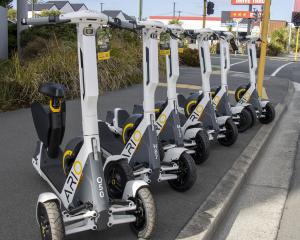Keen was driving home to Ashburton from a four-day fishing trip to Lake Heron on Tuesday last week when the rain started and the sky looked dark blue.
He had just come through the town of Mt Somers. It was about 11.30am and he was travelling at 100km/h along Tramway Rd when ‘‘out of the blue’’ there was a bright flash, as if from a welding gun.
As it enveloped the front of the windscreen and the driver’s side of the car, there was a loud hushing noise.
Keen believed it was a freak bolt of lightning.
‘‘It was just like a flying saucer. It hit the front of the windscreen,’’ Keen said.
At the same time, it had felt like there was high pressure in the interior of his car.
‘‘The feeling of the strike was so fierce, if I was outside the car I would not have lived, it was so strong,’’ he said.
He just kept driving, did not slow down, but was shaken by the experience.
‘‘The only reason I think it saved me was the tyres, it didn’t earth to the ground.’’
It was his third close call with lightning in his life.
The first was when he was eight and living in Mataura near Gore.
He was outside in a thunderstorm when he took shelter under a tree.
When it stopped raining he decided he would ‘‘make a run for it’’.He turned around as he was running away and saw the tree split in half by a strike of lightning.
‘‘I could hear it, it was like a big split, bang!’’
The second time was when he was working as a shearer in Western Australia at the age of 32.
Shearing in a shed near a 2m opening at its side, Keen decided to put down his handpiece as a powerful thunderstorm rolled in.
Moments later lighting hit the turning wheel at the top of his shearing shaft connected to the handpiece he had just been holding.
There was a loud crack and sparks flew from the metal.
‘‘This third time, gee whizz, this was the closest I have ever been,’’ Keen said.
‘‘The force of lightning is so powerful, you have to see it to believe it.’’
Dr Craig Rodger, a researcher in global lightning detection at the University of Otago, said the frame of cars offered a protective factor.
‘‘Being in a big metal cage should protect you from getting electrocuted - that doesn’t mean the car will enjoy the experience.’’
In November 2022, a Hokitika man’s ute burst into flames from a strike of lightning.
As Caleb Harris was driving north to Golden Bay in a storm, a bright flash appeared before his eyes, the car shook and his ears were ringing.
Everything was smoking and he spotted flames as he pulled over. The car was destroyed by the fire and Harris spent a night in hospital where doctors monitored his heart.
Keen's van also sustained damage, to its paintwork. Above a window on the driver’s side, there is a 40cm-long jagged mark.
Keen was grateful his trusty 2001 Toyota Grand-Hiace, which he slept in when he went on fishing trips, was apparently otherwise unharmed.
He said as a Christian, he had thanked God he was alive, knowing the lightning had struck at such a close distance to his head while he was driving.

His first wife Liz died of cancer; his second wife Jan died aged 57 in January after suffering an illness for some time.
‘‘But the good Lord was good to me with this lightning,’’ he said.
‘‘I’m lucky I’m bloody here really.’’
MetService meteorologist Lewis Ferris said there were not any lightning strikes picked up on Tuesday last week, anywhere in the country.
The MetService uses a nationwide tracking network of stations to record strikes, believed to have a detection efficiency of more than 95 per cent.
The MetService’s record of weather around Mt Somers at that time and on that day was cloudy with patchy light rain, as a frontal system was passing by.
Dr Rodger said while unlikely it was possible the network missed the strike reported by Keen.
‘‘It is also possible that the thunderstorm only made one lightning bolt,’’ Rodger said.
















